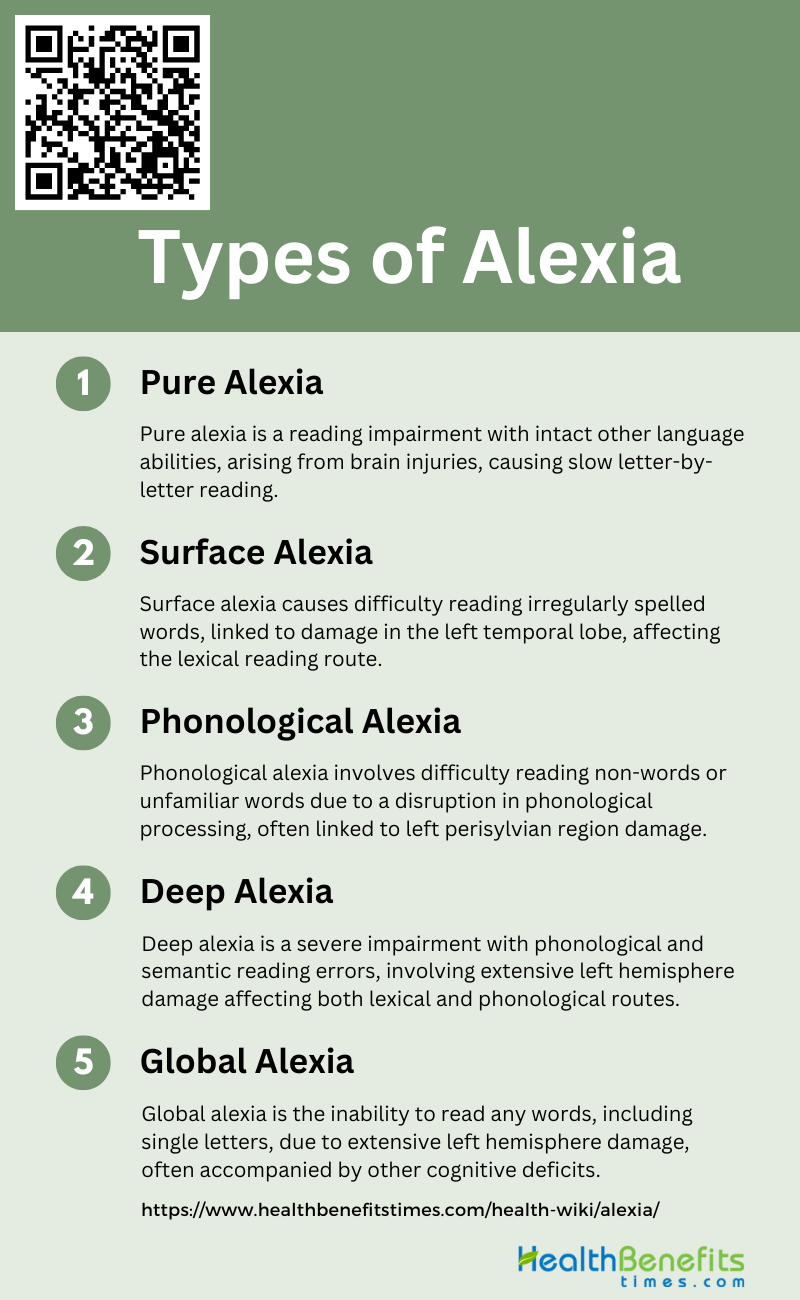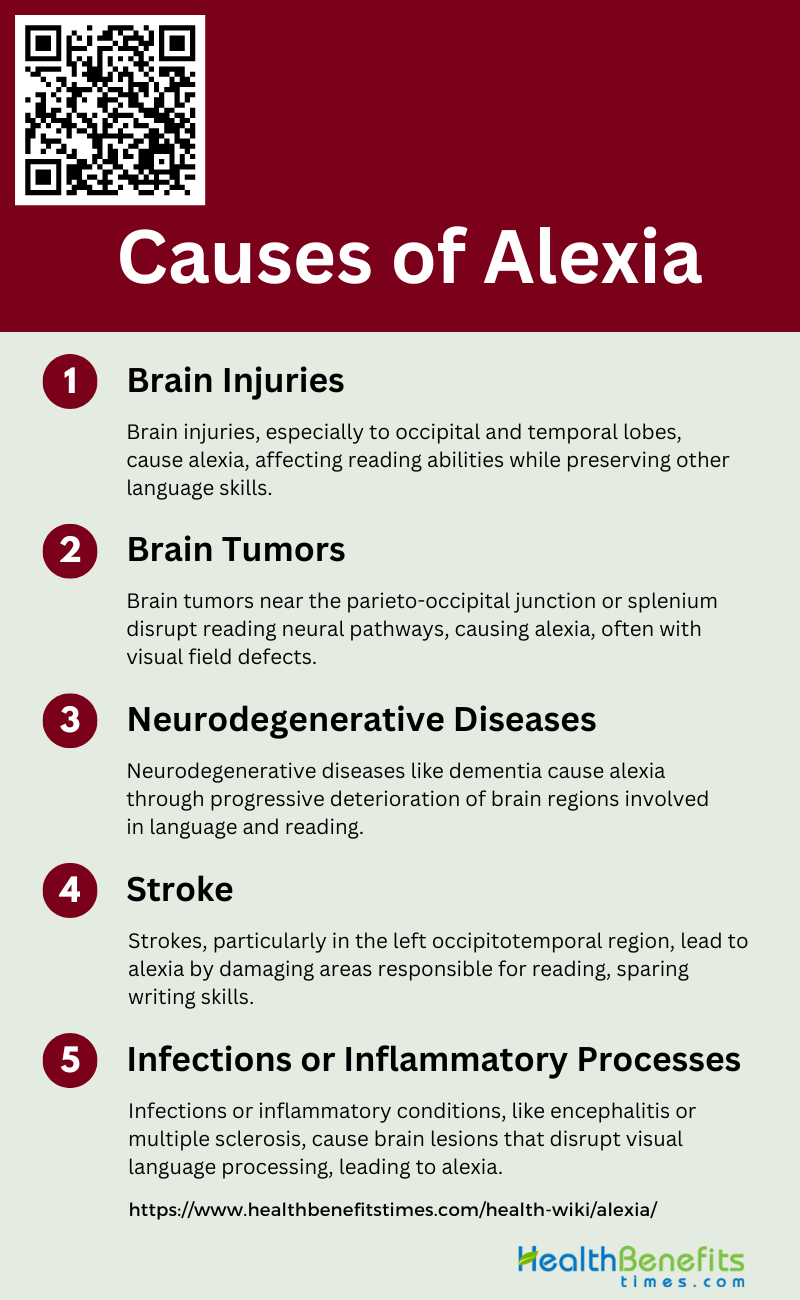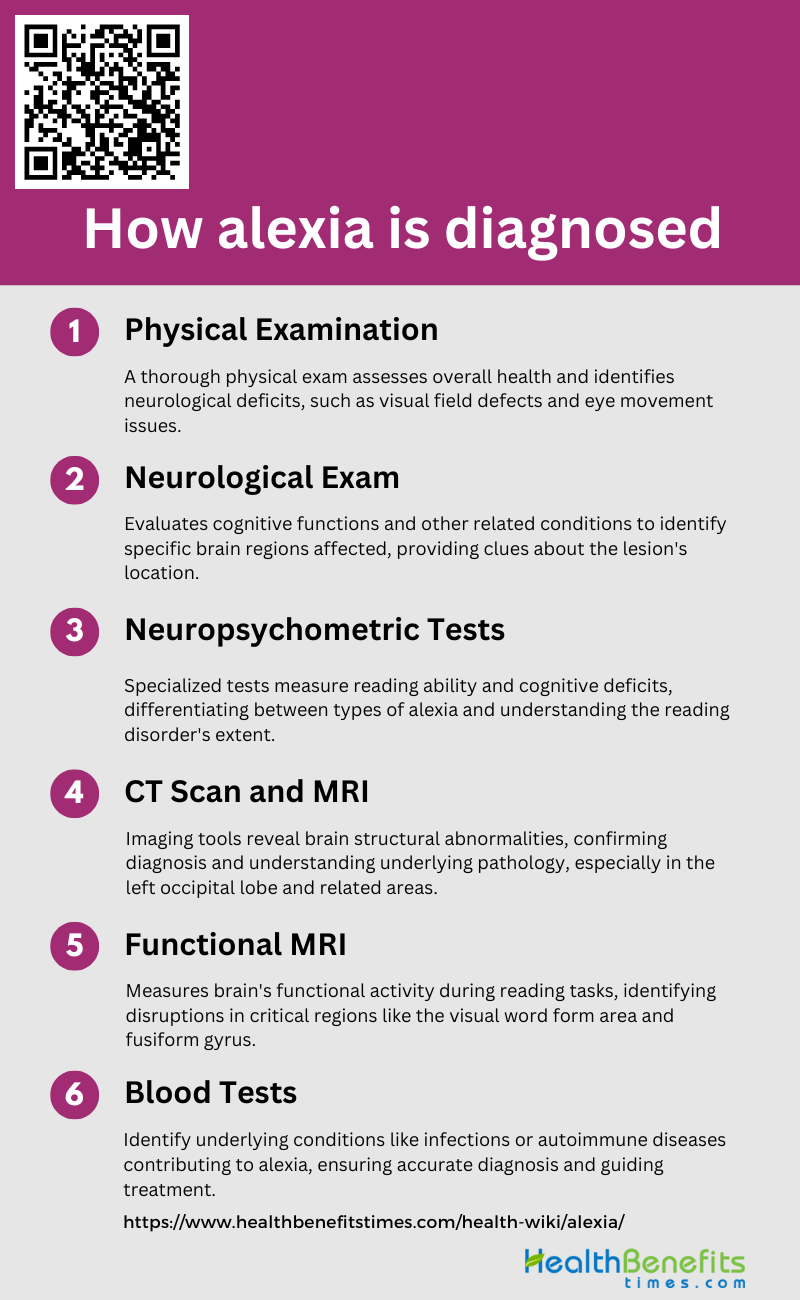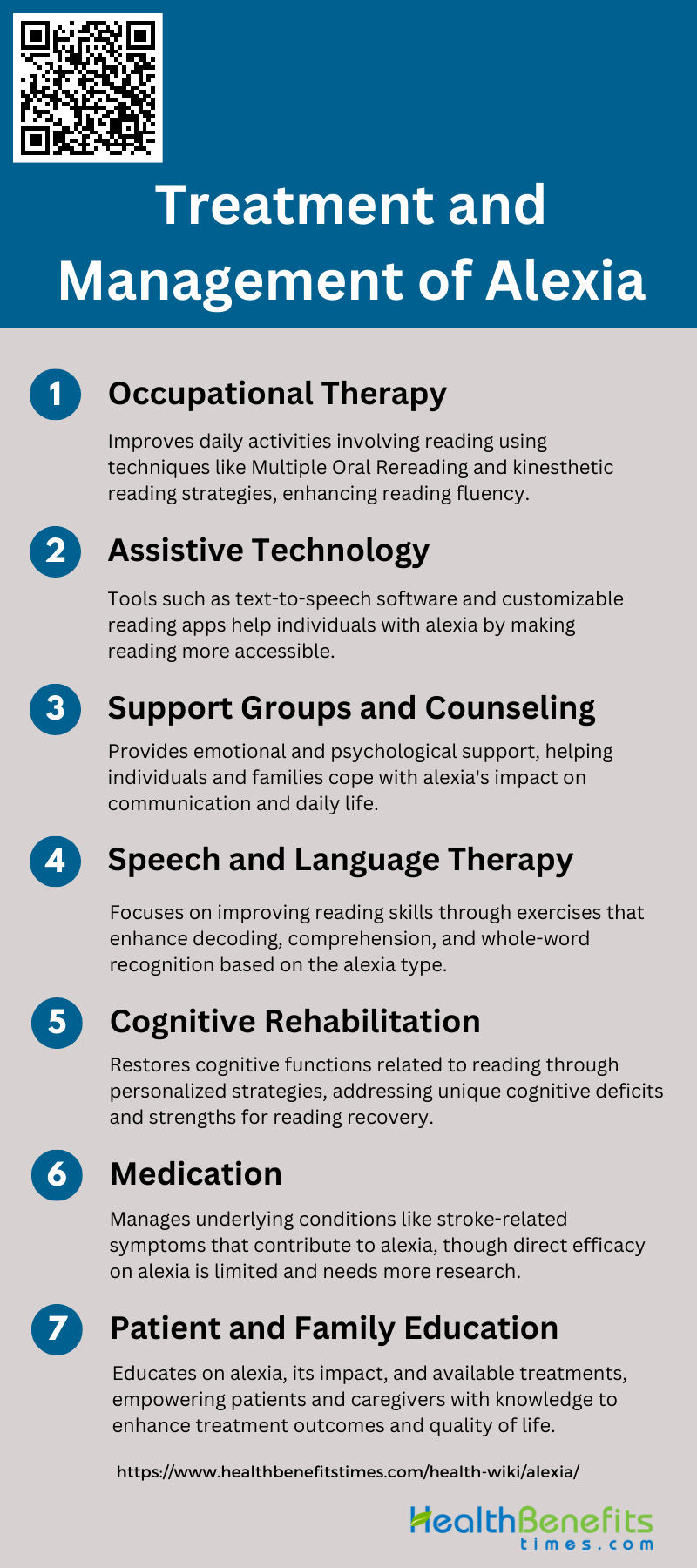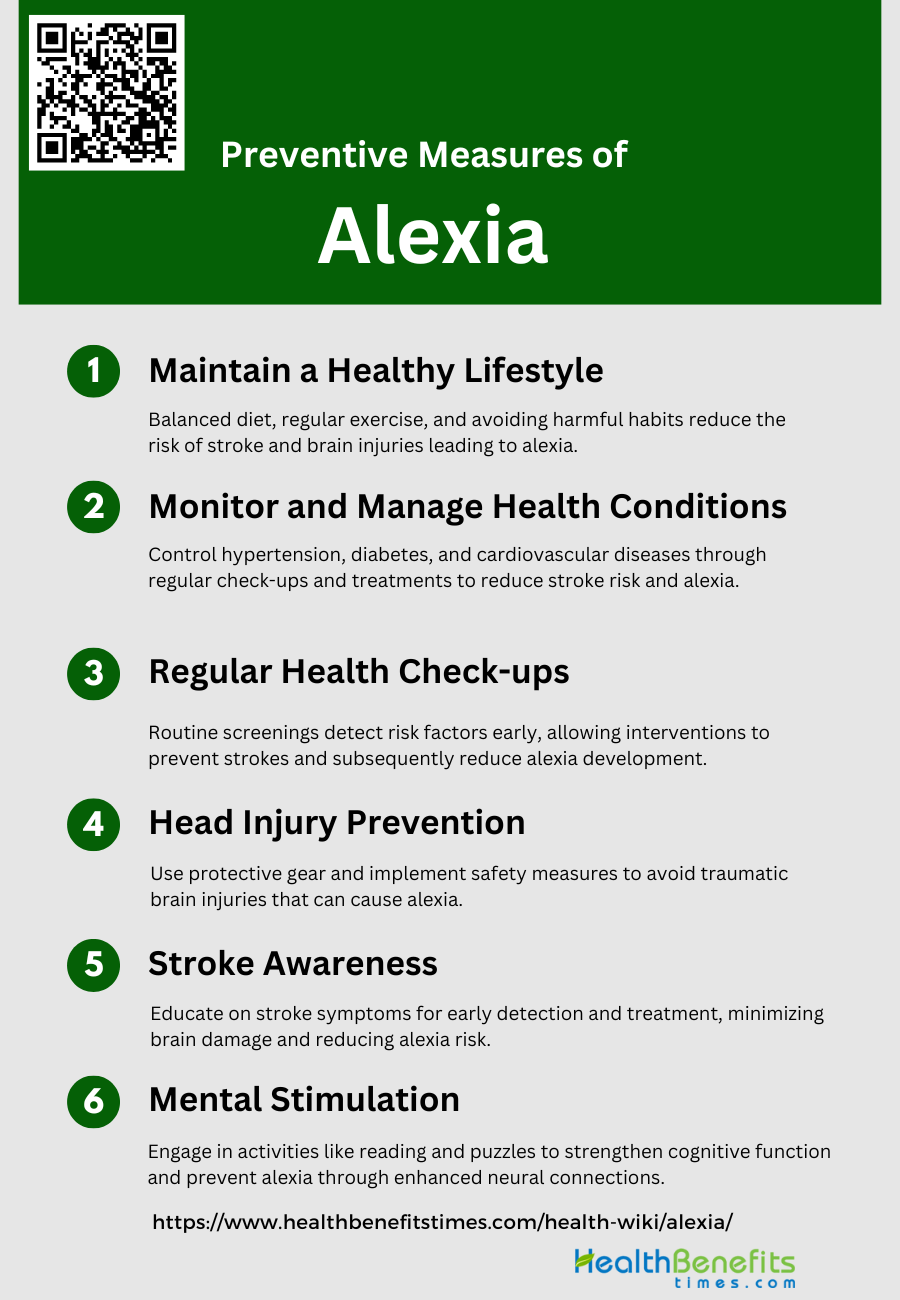 Alexia, also known as word blindness or acquired dyslexia, is a neurological condition characterized by an inability to read or comprehend written words, despite having normal vision and intelligence. It typically occurs after a brain injury or stroke that affects the areas of the brain responsible for processing visual information and language. Individuals with alexia can still write and speak fluently, but they struggle to recognize and understand written words, even those they could previously read with ease. This disconnection between the visual and language processing systems in the brain results in a specific impairment in reading abilities while other language functions remain intact.
Alexia, also known as word blindness or acquired dyslexia, is a neurological condition characterized by an inability to read or comprehend written words, despite having normal vision and intelligence. It typically occurs after a brain injury or stroke that affects the areas of the brain responsible for processing visual information and language. Individuals with alexia can still write and speak fluently, but they struggle to recognize and understand written words, even those they could previously read with ease. This disconnection between the visual and language processing systems in the brain results in a specific impairment in reading abilities while other language functions remain intact.
Types of Alexia
Below is a list of the recognized types of alexia that medical professionals and researchers have identified.
1. Pure Alexia
Pure alexia, also known as “alexia without agraphia,” is a selective impairment in reading while other language abilities remain intact. This condition typically arises from brain injuries affecting previously literate individuals. Patients with pure alexia often read in a letter-by-letter manner, which significantly slows down their reading process. The disorder has been extensively studied within cognitive neuropsychology, revealing that it can result from lesions in the fusiform gyrus or the splenium of the corpus callosum. Despite the impairment, some patients can still perform lexical decision tasks and forced-choice semantic categorization, suggesting that some reading abilities are preserved.
2. Surface Alexia
Surface alexia is characterized by difficulty in reading irregularly spelled words, while the ability to read regularly spelled words and non-words remains relatively intact. This condition suggests a disruption in the lexical route of reading, which is responsible for recognizing whole words and their meanings. Patients with surface alexia often rely on phonological decoding, which lead to errors when reading words that can do not follow standard phonetic rules. This type of alexia is often associated with damage to the left temporal lobe, which plays a crucial role in processing the visual form of words and their semantic meanings.
3. Phonological Alexia
Phonological alexia involves a difficulty in reading non-words or unfamiliar words, while the ability to read familiar words remains relatively preserved. This condition indicates a disruption in the phonological route of reading, which is essential for decoding the sounds of letters and words. Research has identified two distinct types of phonological alexia, each with different underlying causes and symptoms. This type of alexia is often linked to damage in the left perisylvian region, which is crucial for phonological processing.
4. Deep Alexia
Deep alexia is a severe form of reading impairment where patients exhibit both phonological and semantic reading errors. This condition is characterized by the inability to read non-words, frequent semantic errors (e.g., reading “cat” as “dog”), and difficulty with function words. Deep alexia is often associated with extensive damage to the left hemisphere, particularly in areas involved in both phonological and semantic processing. This type of alexia suggests a breakdown in multiple components of the reading system, including both the lexical and phonological routes.
5. Global Alexia
Global alexia is the most severe form of alexia, where patients are unable to read any words, including single letters. This condition is often a result of extensive damage to the left hemisphere, affecting regions responsible for both visual and language processing. Patients with global alexia may also exhibit other cognitive deficits, such as visual agnosia and acalculia. The severity of this condition highlights the critical role of the left hemisphere in integrating visual and linguistic information for reading.
Differences between dyslexia and alexia
Dyslexia and alexia are both reading disorders, but they differ significantly in their origins and manifestations. Dyslexia is a developmental, brain-based learning disability that typically presents in childhood and affects a person’s ability to read, spell, and process language despite normal intelligence and educational opportunities. It is characterized by difficulties with phonological processing, reading fluency, spelling, and rapid visual-verbal responding, and can be inherited with genetic predispositions identified in recent studies. In contrast, alexia, also known as acquired dyslexia, is a reading disorder that occurs due to brain injury or neurological damage, often affecting the left fusiform gyrus, occipito-temporal sulcus, and inferior temporal gyrus, which are critical for visual word form processing. While dyslexia is a lifelong condition that can be managed with early intervention and specialized teaching strategies, alexia results from specific brain lesions and often involves a disproportionate increase in reading time relative to word length, with varying impacts depending on the extent and location of the brain damage.
Causes of Alexia
Alexia, also known as acquired dyslexia, is primarily caused by brain damage resulting from various neurological events. The most common causes include:
1. Brain Injuries
Brain injuries, particularly those affecting the occipital and temporal lobes, are a significant cause of alexia. For instance, pure alexia, characterized by the inability to read despite intact writing abilities, is often linked to damage in the left ventral occipitotemporal cortex or its connections. Additionally, traumatic brain injuries can lead to less consistent reading deficits compared to focal lesions. The impairment in visuospatial perception due to right thalamic injury can also mimic pure alexia, highlighting the role of brain injuries in causing this condition.
2. Brain Tumors
Brain tumors can lead to alexia by disrupting the neural pathways involved in reading. Tumors located near the parieto-occipital junction or the splenium of the corpus callosum can cause alexia, often accompanied by agraphia and visual field defects. The presence of a tumor in the left occipitotemporal junction can compromise both interhemispheric and intrahemispheric visual pathways, leading to pure alexia. These tumors can cause localized damage that interrupts the visual language processing areas, resulting in reading impairments.
3. Neurodegenerative Diseases
Neurodegenerative diseases, such as dementia, can also cause alexia. These conditions often lead to progressive deterioration of brain regions involved in language and reading. While the patterns of reading deficits in neurodegenerative diseases are less consistent than those seen in focal lesions, they still significantly impact the ability to read. The gradual loss of neural function in areas responsible for visual language processing can lead to alexia, highlighting the role of neurodegenerative diseases in this condition.
4. Stroke
Strokes are a common cause of alexia, particularly when they affect the left occipitotemporal region. Ischemic or hemorrhagic strokes can lead to pure alexia, where patients lose the ability to read but retain their writing skills. Strokes in the posterior cerebral artery territory can cause infarction in the left occipital lobe and the splenium of the corpus callosum, leading to alexia. Additionally, strokes can cause alexia with agraphia when they affect the inferior posterior region of the left temporal lobe.
5. Infections or Inflammatory Processes
Infections or inflammatory processes in the brain can also result in alexia. Conditions such as encephalitis or multiple sclerosis can cause lesions in the brain regions responsible for reading. These lesions can disrupt the neural pathways involved in visual language processing, leading to alexia. For example, nonconvulsive status epilepticus, an inflammatory condition, has been reported to cause pure alexia, which resolved with appropriate treatment. This highlights the impact of infections and inflammatory processes on the development of alexia.
Sign and Symptoms of Alexia
Below is a list of the key signs and symptoms associated with Alexia.
1. Difficulty Reading
This condition can present suddenly, as seen in cases of acute cerebral hemorrhage or multiple sclerosis, where patients report an abrupt onset of difficulty in reading despite having no prior issues. The inability to read can be isolated, with patients maintaining other cognitive functions such as writing and oral comprehension, highlighting the specificity of the reading impairment.
2. Letter Transpositions
Patients with alexia may experience letter transpositions, where letters within words are misread or misplaced. This symptom is indicative of a disruption in the visual processing pathways that connect the visual cortex to the language centers in the brain. Such disruptions can result from lesions in the left occipitotemporal region, which interfere with the brain’s ability to process and recognize the correct sequence of letters in words. This phenomenon underscores the complexity of the neural mechanisms involved in reading and the precise localization of brain lesions that can affect this ability.
3. Inability to Read Non-Words
A hallmark of phonological alexia is the inability to read non-words or unfamiliar words, which require phonological decoding. This condition arises from a disturbance in the phonological reading process, while the non-phonological reading process remains intact. Patients can read familiar words but struggle with non-words, indicating a specific impairment in the phonological stage of reading. This dissociation highlights the distinct neural pathways involved in different aspects of reading and the selective vulnerability of these pathways to certain types of brain lesions.
4. Semantic Errors
Semantic errors, where patients substitute words with similar meanings or related concepts, are another symptom of alexia. These errors suggest a disruption in the semantic processing pathways, which can occur due to lesions in the left posterior cerebral artery territory. Such lesions can affect the brain’s ability to access and process the meaning of words, leading to errors in reading comprehension. The presence of semantic errors in reading further illustrates the complex interplay between different cognitive processes involved in reading.
5. Visual Field Defects
Visual field defects, such as hemianopsia or quadrantanopia, are commonly associated with alexia. These defects result from lesions in the occipital lobe or the visual pathways, which can impair the visual input necessary for reading. For instance, right homonymous hemianopsia is frequently observed in patients with pure alexia, indicating a lesion in the left occipital lobe that disrupts the visual information flow to the language centers. The co-occurrence of visual field defects and alexia underscores the importance of intact visual processing for reading.
6. Writing Skills Intact
One of the defining features of alexia without agraphia is the preservation of writing skills despite severe reading impairment. Patients can write fluently and correctly but are unable to read what they have written. This dissociation suggests that the neural pathways for writing are distinct from those for reading and that specific lesions can selectively impair reading without affecting writing. The intact writing ability in alexia without agraphia highlights the modular organization of language functions in the brain.
7. Comprehension Issues
Comprehension issues in alexia can range from difficulty understanding written text to more profound impairments in processing the meaning of words. These issues are often linked to lesions in the left posterior cerebral artery territory, which can disrupt the neural networks involved in semantic processing and reading comprehension. Patients may exhibit a range of comprehension deficits, from mild difficulties in understanding complex sentences to severe impairments in grasping the meaning of simple words, reflecting the extent and location of the brain lesion.
How alexia is diagnosed
Being diagnosed with alexia can be a life-altering event, as it affects the ability to read, a skill fundamental too many aspects of daily life. Below is a list of considerations and steps to take following a diagnosis of alexia.
1. Physical Examination
Physical examination is a crucial initial step in diagnosing alexia. It involves a comprehensive assessment of the patient’s general health and neurological status. Clinicians look for signs of neurological deficits, such as visual field defects, which are common in alexia patients. For instance, right homonymous hemianopia is frequently observed in individuals with pure alexia, indicating a possible lesion in the left occipital lobe or splenium of the corpus callosum. Additionally, physical examination can reveal other symptoms like nystagmus, partial paralysis of eye adduction, and cerebellar ataxia, which may accompany alexia in conditions like multiple sclerosis.
2. Neurological Exam
A detailed neurological exam is essential to pinpoint the specific brain regions affected in alexia. This exam includes evaluating the patient’s cognitive functions, such as memory, language comprehension, and visual recognition. For example, patients with alexia often exhibit intact oral language comprehension and the ability to name objects and colors, but struggle with reading. The neurological exam also assesses the presence of other related conditions, such as color anomia and optic ataxia, which can provide clues about the lesion’s location in the brain .
3. Neuropsychometric Tests
Neuropsychometric tests are specialized assessments designed to evaluate the cognitive deficits associated with alexia. These tests measure various aspects of reading ability, including word recognition, reading speed, and error patterns. For instance, patients with pure alexia may show a significant prolongation of reading time as a function of word length and make frequent phonemic errors. These tests help differentiate between different types of alexia, such as phonological alexia, where the phonological reading process is specifically impaired. Neuropsychometric tests are crucial for understanding the extent and nature of the reading disorder.
4. CT Scan and MRI
CT scans and MRIs are vital imaging tools used to identify structural abnormalities in the brain that may cause alexia. These imaging techniques can reveal lesions in specific brain regions, such as the left occipital lobe, splenium of the corpus callosum, and occipitotemporal junction, which are commonly associated with alexia. For example, MRI scans can show hyperintense lesions in the periventricular regions and brainstem in patients with multiple sclerosis who develop alexia. These imaging findings are crucial for confirming the diagnosis and understanding the underlying pathology.
5. Functional MRI
Functional MRI (fMRI) provides insights into the brain’s functional activity by measuring changes in blood flow. This technique is particularly useful in studying the neural mechanisms underlying alexia. fMRI can identify areas of the brain that are activated during reading tasks, helping to pinpoint functional disruptions in the visual word form area and other related regions. For instance, fMRI studies have shown that damage to the left fusiform gyrus and occipitotemporal sulcus is associated with pure alexia, highlighting the importance of these regions in reading. Functional MRI thus aids in understanding the functional impact of structural lesions.
6. Blood Tests
Blood tests are not directly used to diagnose alexia but can help identify underlying conditions that may contribute to the disorder. For example, blood tests can detect infections, autoimmune diseases, or metabolic disorders that might cause or exacerbate alexia. In cases where alexia is associated with multiple sclerosis or HIV infection, blood tests can confirm the presence of these conditions and guide appropriate treatment. Additionally, blood tests can help rule out other potential causes of cognitive impairment, ensuring a more accurate diagnosis of alexia.
Treatment and Management of Alexia
Dealing with alexia involves various strategies and approaches aimed at improving reading ability and overall quality of life. Below is a list of key treatment and management strategies for individuals diagnosed with alexia.
1. Occupational Therapy
Occupational therapy for alexia focuses on improving the patient’s ability to perform daily activities that involve reading. Techniques such as Multiple Oral Rereading (MOR) have shown promise in enhancing reading speed and accuracy in individuals with alexia. Therapists may also incorporate kinesthetic reading strategies, where patients trace letters with their fingers to aid in letter recognition and reading fluency. These interventions aim to leverage the patient’s residual abilities and adapt their environment to support functional reading skills, ultimately improving their quality of life.
2. Assistive Technology
Assistive technology plays a crucial role in managing alexia by providing tools that facilitate reading and comprehension. Devices such as text-to-speech software can help patients by converting written text into spoken words, thereby bypassing the impaired reading process. Additionally, specialized reading apps and e-readers with customizable text settings (e.g., font size, color contrast) can make reading more accessible for individuals with visual and cognitive deficits associated with alexia. These technologies offer practical solutions that enhance independence and daily functioning.
3. Support Groups and Counseling
Support groups and counseling provide emotional and psychological support to individuals with alexia and their families. These groups offer a platform for sharing experiences, coping strategies, and resources, which can alleviate feelings of isolation and frustration. Counseling can address the emotional impact of alexia, helping patients and their families to adjust to the changes in communication and daily life. By fostering a supportive community, these interventions contribute to the overall well-being and mental health of those affected by alexia.
4. Speech and Language Therapy
Speech and language therapy is a cornerstone in the treatment of alexia, focusing on improving reading skills through targeted exercises. Techniques such as phonological treatment, which enhances the ability to decode and comprehend written words, have shown effectiveness in patients with phonological alexia. Therapists may also use top-down and bottom-up approaches to strengthen lexical and semantic connections, thereby improving whole-word recognition and reading fluency. These therapies are tailored to the specific type of alexia and the individual needs of the patient.
5. Cognitive Rehabilitation
Cognitive rehabilitation aims to restore cognitive functions related to reading by employing various strategies and exercises. For example, interventions may focus on enhancing visual processing and eye movement control in patients with hemianopic alexia, where visual field deficits impact reading speed. Techniques such as tactile-kinesthetic training can improve letter identification and reading accuracy in more severe cases of alexia. Cognitive rehabilitation is often personalized, addressing the unique cognitive deficits and strengths of each patient to optimize reading recovery.
6. Medication
While medication is not a primary treatment for alexia, it can be used to manage underlying conditions that contribute to the disorder. For instance, medications that address stroke-related symptoms or other neurological conditions may indirectly improve reading abilities by stabilizing the patient’s overall health. However, there is limited evidence on the direct efficacy of medication in treating alexia, and more research is needed to explore potential pharmacological interventions.
7. Patient and Family Education
Educating patients and their families about alexia is essential for effective management and support. Understanding the nature of the disorder, its impact on daily life, and the available treatment options can empower patients and their caregivers to make informed decisions. Education programs may include training on how to use assistive technologies, strategies for improving reading skills, and ways to create a supportive home environment. By fostering knowledge and awareness, these programs help to enhance the overall treatment outcomes and quality of life for individuals with alexia.
Preventive measures of Alexia
To mitigate the risks and manage the condition effectively, it is crucial to adopt a series of preventive measures. Below is a list of strategies to help prevent the onset or progression of Alexia.
1. Maintain a Healthy Lifestyle
Maintaining a healthy lifestyle is crucial in preventing various neurological conditions, including alexia. A balanced diet, regular physical activity, and avoiding harmful habits such as smoking and excessive alcohol consumption can significantly reduce the risk of stroke and other brain injuries that may lead to alexia. Studies have shown that a healthy lifestyle can also help prevent diseases associated with cognitive decline, such as Alzheimer’s disease, which shares some risk factors with alexia. By adopting healthy habits, individuals can protect their brain health and reduce the likelihood of developing alexia.
2. Monitor and Manage Health Conditions
Effective monitoring and management of health conditions such as hypertension, diabetes, and cardiovascular diseases are essential in preventing alexia. These conditions can increase the risk of stroke, which is a common cause of acquired alexia. Regular medical check-ups and adherence to prescribed treatments can help control these conditions, thereby reducing the risk of stroke and subsequent alexia. Additionally, managing health conditions can prevent complications that may exacerbate cognitive impairments and reading difficulties.
3. Regular Health Check-ups
Regular health check-ups play a vital role in the early detection and prevention of conditions that could lead to alexia. Routine screenings for blood pressure, cholesterol levels, and blood sugar can help identify risk factors for stroke and other brain injuries. Early intervention and treatment of these risk factors can prevent the occurrence of strokes, thereby reducing the likelihood of developing alexia. Health check-ups also provide an opportunity for healthcare providers to educate patients on maintaining brain health and preventing cognitive decline.
4. Head Injury Prevention
Preventing head injuries is a critical measure in reducing the risk of alexia. Traumatic brain injuries can lead to various cognitive impairments, including alexia. Wearing protective gear during high-risk activities, such as sports and cycling, and implementing safety measures at home and in the workplace can help prevent head injuries. Additionally, raising awareness about the importance of head injury prevention can contribute to reducing the incidence of brain injuries and their associated cognitive deficits.
5. Stroke Awareness
Increasing awareness about stroke and its symptoms is essential in preventing alexia. Strokes are a leading cause of acquired alexia, and timely medical intervention can significantly reduce the severity of cognitive impairments. Educating the public about the signs of stroke, such as sudden numbness, confusion, and difficulty speaking, can promote early detection and treatment. Immediate medical attention during a stroke can minimize brain damage and improve recovery outcomes, thereby reducing the risk of developing alexia.
6. Mental Stimulation
Engaging in activities that stimulate the brain can help maintain cognitive function and prevent alexia. Mental exercises, such as reading, puzzles, and learning new skills, can strengthen neural connections and enhance cognitive resilience. Research suggests that cognitive stimulation can protect against cognitive decline and improve recovery in individuals with alexia. By incorporating mentally stimulating activities into daily routines, individuals can support their brain health and reduce the risk of developing alexia.


